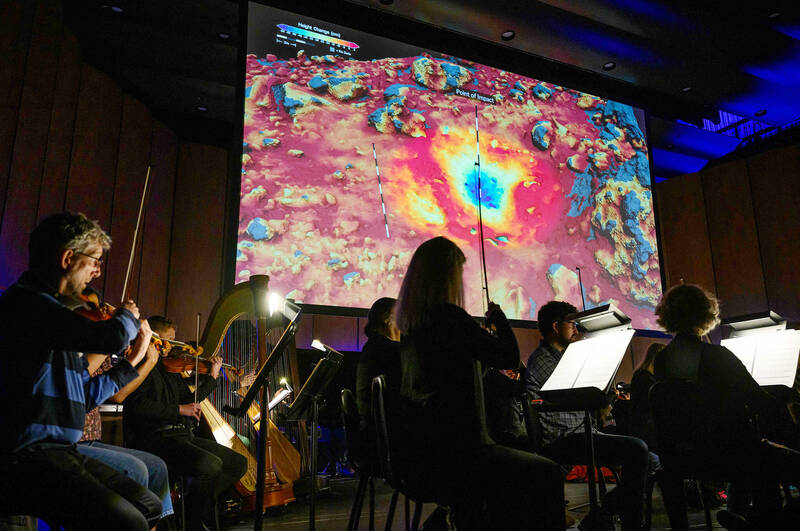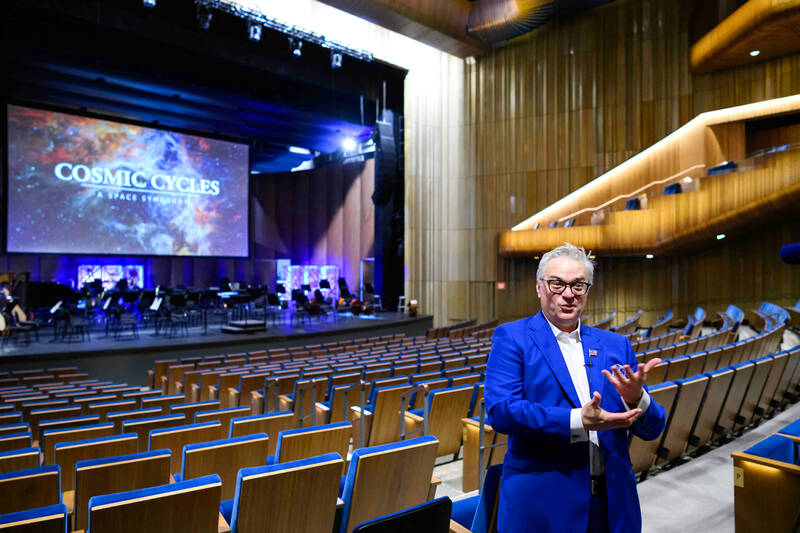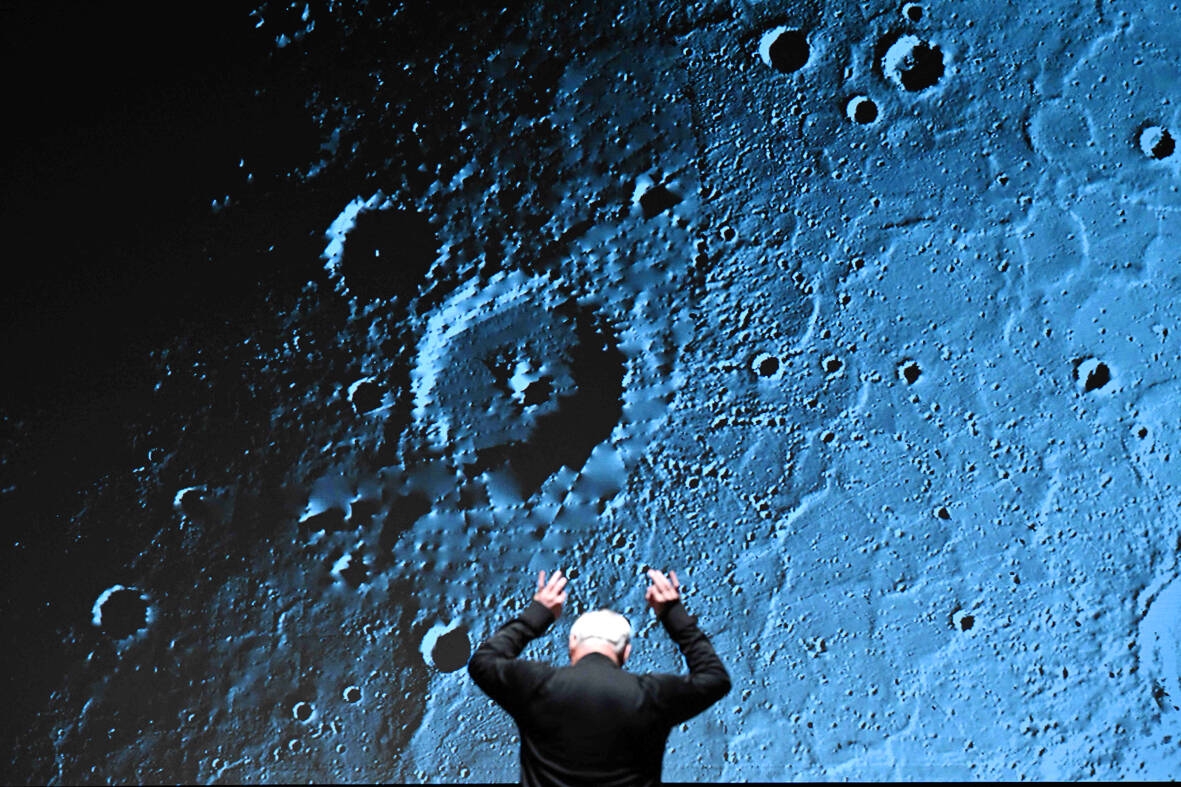It could be the ultimate blend of art and science — a new seven-suite “space symphony” inspired and illustrated by NASA’s latest mind-boggling images.
The world premiere outside Washington last week of Cosmic Cycles showcased vivid imagery compiled by the US space agency alongside the first-ever public performance of the music.
Henry Dehlinger, the symphony’s American composer, describes it as “almost like a total artwork.”

Photo: AFP
“It’s not just music, it’s not just visuals — it’s not a score for a film either,” the 56-year-old told AFP said before the concert.
“It’s more of an immersive experience that encapsulates both visuals and sound.”
A similar effort was undertaken over a century ago by English composer Gustav Holst — but when he wrote his famous ode to The Planets, much in astronomy remained only theoretical.

Photo: AFP
Since then, humans have walked on the Moon, sent roving research labs to Mars and probed across the solar system with powerful telescopes allowing us to peer billions of light-years away.
The images from that research, compiled by NASA producers into seven short films, served as the inspiration for Dehlinger.
“I had to almost pinch myself and remind myself that this isn’t pretend — this is the real deal. Not science fiction, it’s the actual science,” he said.

Photo: AFP
Piotr Gajewski, music director and conductor of the National Philharmonic, explained that the idea for the project came after previous work with NASA on visuals to go with a double-billing of Claude Debussy’s La Mer (“The Sea”) and Holst’s The Planets.
For their next collaboration, 64-year-old Gajewski said he suggested to NASA “that we turn the tables on them.”
“Rather than them getting a piece of music and putting pictures to it, that they start by putting short videos together... of their very, very best work.”
For Wade Sisler, executive producer at NASA’s Goddard Space Flight Center, the challenge was worth the effort.
“It’s a journey unlike one that I have ever helped anyone take,” Sisler, 64, said
‘LIKE VAN GOGH PAINTINGS’
The seven-part piece begins at the heart of our solar system — the Sun — with shots of its swirling and gurgling surface, and explosions of particles out to the planets.
The next two movements focus on NASA studies of our home planet, from a global perspective and then through Earth photographs taken by astronauts in orbit.
Apart from photos and videos, interspersed throughout the seven films are a “mesmerizing collection of data visualizations” created by NASA, Sisler explained.
Data on ocean currents, for example, “look like Van Gogh paintings when you put them in motion. The colors are beautiful, you see patterns that you never realized before.”
A fourth segment on the Moon is followed by profiles of each planet — including a focus on images of the Martian surface taken by NASA rovers.
Jupiter, a “regal subject” according to Dehlinger, is introduced by roaring chimes and horns.
The symphony also takes a detailed look at recent experiments on asteroids before a big finale of nebulae, black holes and other galactic phenomena.
In addition to two performances at venues outside Washington, NASA has released the videos to its YouTube page with a synthesized version of Dehlinger’s soundtrack.
‘A GREAT MYSTERY’
To hammer home the equal importance of the music and video, conductor Gajewski explained, they decided not to aim for exact synchronization, but to be more “fluid.”
That approach allows him “to find some moments that are different each time and each performance.”
“We really wanted people to be able to experience the music, the performers themselves, and also the science in a balanced portfolio,” Sisler added.
Knowing the images and missions were real, Sisler said, elicits a stronger audience response in the digital age, when “you can conjure up anything through AI, conjure up anything in digital effects.”
“People are interested in real results. Like ‘wow, we really went to that asteroid. Wow, we’re really bringing it back here to Earth,’” he said, referring to the daring OSIRIS-REx sample retrieval mission.
That awe-inspiring factor made the images perfect companions to orchestral pieces, Gajewski said.
“What is it that all of a sudden makes us emotionally weak when we hear one kind of music, or proud when we hear different kinds?” he asked.
“It’s all a great mystery, and of course space is the other great mystery, so they complement each other very well.”

As Donald Trump’s executive order in March led to the shuttering of Voice of America (VOA) — the global broadcaster whose roots date back to the fight against Nazi propaganda — he quickly attracted support from figures not used to aligning themselves with any US administration. Trump had ordered the US Agency for Global Media, the federal agency that funds VOA and other groups promoting independent journalism overseas, to be “eliminated to the maximum extent consistent with applicable law.” The decision suddenly halted programming in 49 languages to more than 425 million people. In Moscow, Margarita Simonyan, the hardline editor-in-chief of the

Six weeks before I embarked on a research mission in Kyoto, I was sitting alone at a bar counter in Melbourne. Next to me, a woman was bragging loudly to a friend: She, too, was heading to Kyoto, I quickly discerned. Except her trip was in four months. And she’d just pulled an all-nighter booking restaurant reservations. As I snooped on the conversation, I broke out in a sweat, panicking because I’d yet to secure a single table. Then I remembered: Eating well in Japan is absolutely not something to lose sleep over. It’s true that the best-known institutions book up faster

The latest Formosa poll released at the end of last month shows confidence in President William Lai (賴清德) plunged 8.1 percent, while satisfaction with the Lai administration fared worse with a drop of 8.5 percent. Those lacking confidence in Lai jumped by 6 percent and dissatisfaction in his administration spiked up 6.7 percent. Confidence in Lai is still strong at 48.6 percent, compared to 43 percent lacking confidence — but this is his worst result overall since he took office. For the first time, dissatisfaction with his administration surpassed satisfaction, 47.3 to 47.1 percent. Though statistically a tie, for most

Though the total area of Penghu isn’t that large, exploring all of it — including its numerous outlying islands — could easily take a couple of weeks. The most remote township accessible by road from Magong City (馬公市) is Siyu (西嶼鄉), and this place alone deserves at least two days to fully appreciate. Whether it’s beaches, architecture, museums, snacks, sunrises or sunsets that attract you, Siyu has something for everyone. Though only 5km from Magong by sea, no ferry service currently exists and it must be reached by a long circuitous route around the main island of Penghu, with the